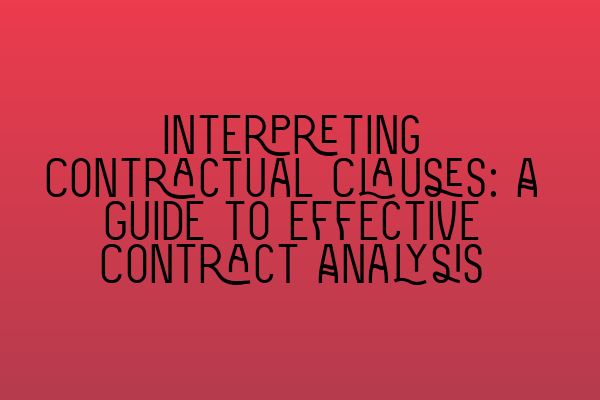Interpreting Contractual Clauses: A Guide to Effective Contract Analysis
Contracts play a vital role in the field of law, governing the rights and obligations of parties involved in various transactions. But what happens when disputes arise over the interpretation of contractual clauses? How can legal professionals effectively analyze and interpret these clauses to ensure fair and just outcomes?
In this comprehensive guide, we will explore the key principles and strategies for interpreting contractual clauses. Whether you are a solicitor, law student, or aspiring legal professional, this guide will equip you with the necessary knowledge and skills to navigate the complexities of contract analysis.
Understanding Contractual Clauses
Before delving into the intricacies of contract analysis, it is essential to understand what contractual clauses are. Contractual clauses are specific provisions within a contract that outline the rights, duties, and responsibilities of the parties involved. These clauses cover a wide range of aspects, including but not limited to payment terms, delivery obligations, termination clauses, and dispute resolution mechanisms.
When interpreting contractual clauses, it is crucial to consider the entire context of the contract, including the purpose, underlying intentions, and surrounding circumstances at the time of drafting. Each clause must be analyzed in relation to other relevant clauses and the overall agreement as a whole.
The Basic Principles of Contract Interpretation
Contract interpretation involves determining the meaning and scope of the contractual clauses. Here are some fundamental principles to keep in mind:
1. Objective Approach:
Contract interpretation should focus on the objective intentions of the parties, rather than their subjective beliefs or intentions. The court will examine the words used in the contract, considering how a reasonable person would understand them.
2. Entire Agreement:
When interpreting a contract, it is crucial to consider the entire agreement as a whole. Individual clauses should not be examined in isolation, but rather in the context of the entire contract. This holistic approach ensures a comprehensive understanding of the parties’ intentions.
3. Clear and Ambiguous Clauses:
The interpretation of clear and unambiguous clauses should be straightforward. However, if a clause is ambiguous or capable of multiple interpretations, the court will apply additional interpretive techniques, such as looking at the commercial context or previous dealings between the parties.
4. Contra Proferentem Rule:
The contra proferentem rule is a principle that places the burden of any ambiguity or uncertainty in a contract on the party who drafted the contract. In case of ambiguity, the court will interpret the contract against the party seeking to rely on it.
Effective Strategies for Contract Analysis
Now that we have covered the basic principles of contract interpretation, let’s explore some effective strategies for contract analysis:
1. Language and Grammar:
Pay close attention to the precise language used in the contractual clauses. Interpret words according to their ordinary meaning, unless a specific technical or trade meaning is implied. Consider the grammatical structure and punctuation within the clause to discern the intended meaning.
2. Purpose and Commercial Context:
Analyzing the purpose and commercial context of the contract can provide valuable insights into the intended meaning of specific clauses. Consider the surrounding circumstances, industry practices, and the parties’ reasonable expectations while interpreting the contract.
3. Previous Dealings:
Examine any previous dealings or course of conduct between the parties, as these can shed light on their intentions while drafting the contract. Consistent patterns of behavior may have contractual implications affecting the interpretation of specific clauses.
4. External Evidence:
In certain cases, external evidence, such as industry customs, trade usage, or negotiations leading up to the contract, may be admissible to understand the parties’ intentions. However, such evidence is secondary to the written terms of the contract and should not contradict or modify clear and unambiguous clauses.
5. Legal Presumptions and Interpretive Aids:
Legal presumptions and interpretive aids can assist in contract analysis. For example, courts may assume that the parties intended to give effect to a particular clause, unless there is evidence to the contrary. Statutory provisions and common law principles may also guide the interpretation process.
Conclusion
Effective contract analysis requires a comprehensive understanding of the basic principles and strategies for interpreting contractual clauses. By approaching contract interpretation objectively, considering the entire agreement, and employing effective strategies, legal professionals can ensure fair and just outcomes in contractual disputes.
If you are preparing for the SQE exams, it is essential to have a solid understanding of contract law and interpretation. Check out our SQE 1 Practice Exam Questions and SQE 1 Practice Mocks FLK1 FLK2 to test your knowledge. For comprehensive preparation, we offer specialized SQE 2 Preparation Courses as well as SQE 1 Preparation Courses. Stay informed about the latest SRA SQE Exam Dates to plan your studies effectively.
